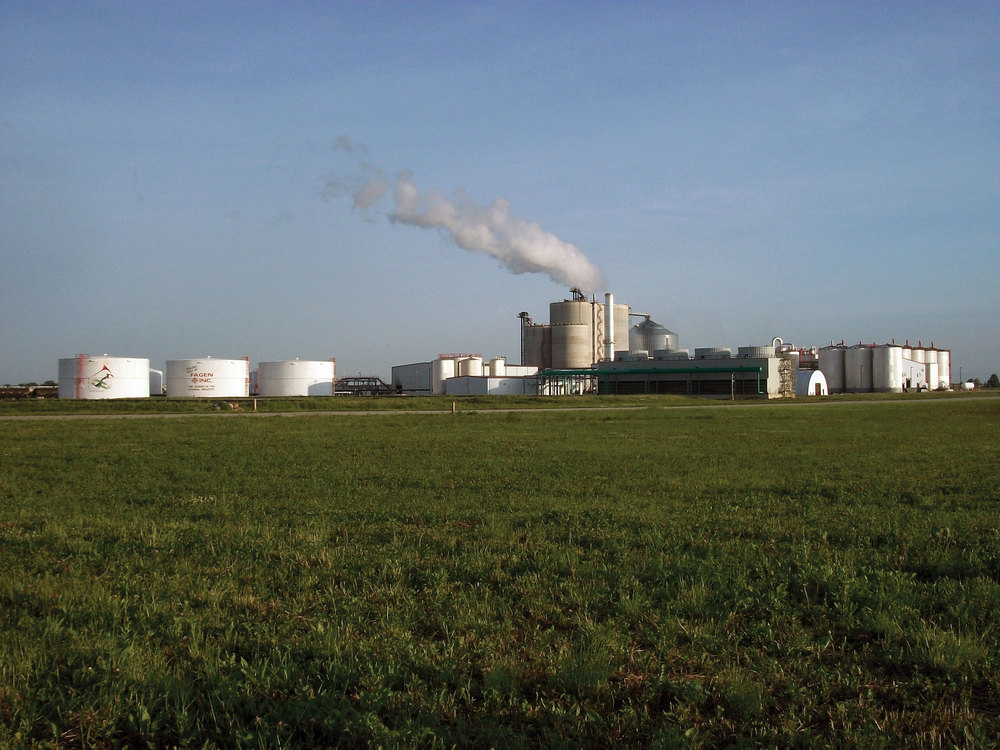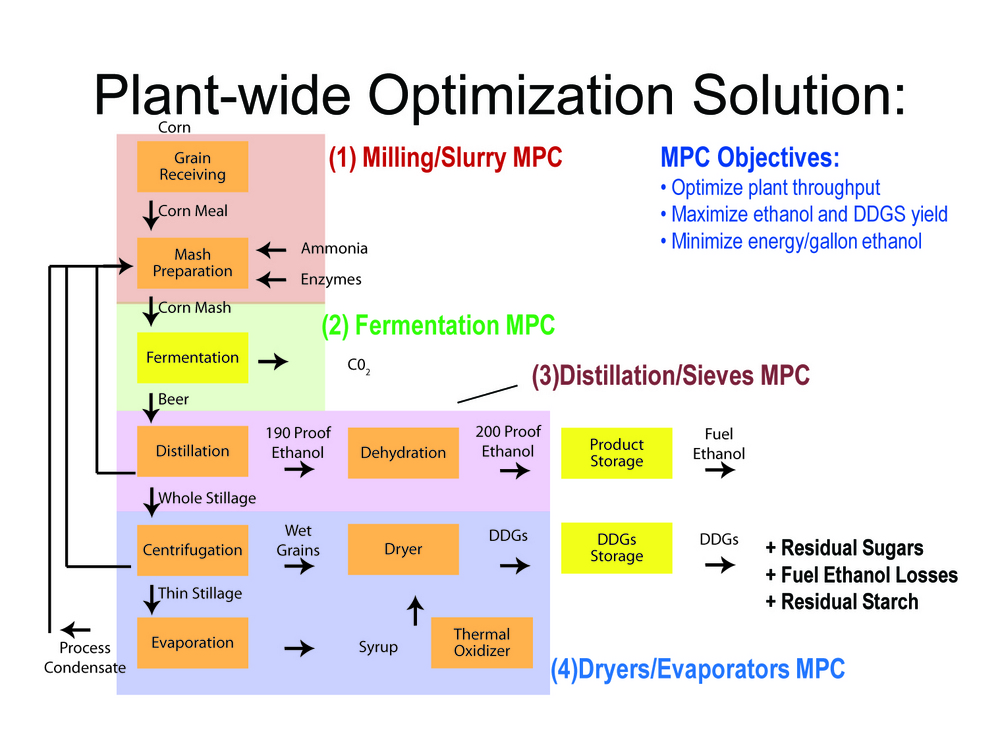Plant-wide Optimization Solution Uses Unified, Integrated Control



June 10, 2011
BY Maina Macharia
Cardinal Ethanol LLC started operations in 2008, formed by a group of local farmers and investors who did their research, procured an excellent plant design and hired an experienced plant management staff to operate the plant with the highest standards and best practices. Knowing that the ethanol business is affected by large swings in corn feedstock costs and fuel ethanol prices, Cardinal hired qualified commodity strategists and risk managers. From the start, clear mission goals were set:
• Maximize value of the facility through strategic and efficient plant operations.
• Improve productivity of the fuel ethanol facility with best-in-class technologies.
• Optimize overall production margin.
• Fuel America’s economic development.
Cardinal Ethanol is located in Union City, Ind., in the Midwest agricultural heartland. The $168 million, 100 MMgy facility processes over 36 million bushels of locally grown corn per year and produces 320,000 tons of DDGS. Cardinal Ethanol is operated and managed by a staff of 49 highly skilled employees. The plant is located on the CSX railroad mainline, facilitating the shipment of DDGS and ethanol to eastern markets. The plant produces more than ethanol, it’s making the next generation of transportation fuel from Indiana-grown crops.
Cardinal’s management and operations staff was tasked with ramping up to capacity within a short time after construction was completed. In addition, this team was to focus on using value-adding technology to unearth greater return from the corn feedstock to maximize the economic margin that could be derived from operations.
The Challenge
Within the first nine months of operation, Cardinal had ramped-up its production to nameplate capacity. Just as it reached its production targets, the economic downturn occurred, causing margins to become razor-thin. The new operating challenges posed by this economic climate were especially troubling to the new plant, and to survive, it looked at several capital projects to improve its margins.
Finding a solution to maximize operating margins proved especially difficult. Cardinal Ethanol’s dry mill plant is highly integrated. All process units— from milling to fermentation, distillation and the dryer systems—are interconnected by energy and material flow, and the extensive process interactions between these units make it difficult to optimize the process. While existing proportional-integral-derivative (PID) controller strategies automate individual portions of plant, these simplified controls do not capture all interactions that can be adjusted to optimize the plant.
So even with well-trained operators, accurate lab measurements and best-in-class PID controls to control each part of the production process, there was still an undesired level of fluctuation seen in key plant variables, including slurry solids, fermenter yield, 200-proof product quality, DDGS product quality and energy per gallon. Each of these variables had gradual swings and a degree of inconsistency. It was clear that an effective solution would need to capture, analyze and control all parts of the plant under a single, unified model.
Cardinal Ethanol turned to Rockwell Automation’s trademarked Pavilion8 technology for model predictive control (MPC), which has the ability to stabilize and drive peak efficiency with a single model of the entire plant. The system could be built and then added as a supervisory control system without modifying existing process equipment. Cardinal was pleased to learn this technology had been implemented in more than 30 ethanol plants in the U.S. and had a track record of making significant margin gains in each operating facility. Having seen these proven results, Cardinal Ethanol chose to install this technology as a plant-wide optimization solution.
Plant-wide Optimization
To install the Pavilion8-based MPC solution, Rockwell Automation application engineers came on-site to build nonlinear dynamic response models and Soft Sensor inferential models based on plant tests and historical data for slurry solids, fermenter HPLC data and syrup solids. Soft Sensor models are inferential measurements that replace lab values and provide continuous control of key lab measurements.
Over the course of the project, the Cardinal Ethanol operators were fully trained in the MPC technology, and the system was gradually implemented in each of the operation areas, until finally given the entire degree of freedom to make optimum control, margin and energy decisions.
The milling and slurry control application reduced the variation of feed quality to the fermenters and helped the plant to safely run at mill amperage limits without tripping the hammermills. In addition, the application improved the water balance of the plant, a critical factor in overall economics—more water results in higher energy costs. The application helped ensure that the slurry had a consistent quality, which in turn, improved the batch fermentation performance with a 54 percent reduction in standard deviation of ethanol from the fermenters.
The application linked the milling and slurry process units with the distillation sieves and the dryer/evaporators process units. It anticipated constraints and ran at higher energy efficiency and higher capacity, increasing production by 7.2 percent.
The batch fermentation control application adjusted the temperature conditions and helped to ensure that enzyme levels are added using the optimal dynamic ratio to feedstock and the best trajectories that respond to changes in feedstock quality. The average of residual sugars was reduced by more than 40 percent. In addition, the standard deviation was reduced in excess of 70 percent. The plant now produces 2.2 percent more ethanol from each bushel of corn. This higher conversion of starch to ethanol, on a consistent basis, essentially yielded more ethanol for the same amount of corn. This was the key factor in the increase of overall margin.
In another area of the plant, Cardinal Ethanol was inefficiently using energy to separate and purify ethanol. The distillation and dehydration control application reduced the variability of energy use by over 50 percent. By optimizing the energy trade-offs between the sieve and distillation operations (within the evaporator energy constraints), energy was reduced. The application also enabled the ethanol to be tightly controlled to the desired moisture specification.
Dryer and evaporator process units remove moisture out of the stillage to form DDGS. This application controlled evaporator solids and dryer moisture while managing stillage inventory and syrup usage. It also controlled the DDGS quality and yield. Since the evaporators are connected to distillation by material and heat, the application considers these interactions and minimized energy use within the process requirements and equipment constraints. The combined energy reduction resulting from optimization of both distillation and dehydration, and evaporation and drying was approximately 7.7 percent— each of these major sections contributing 50 percent of the energy improvements.
Measuring Value
Both Rockwell Automation and Cardinal Ethanol insisted that the results of the plant-wide optimization solution be measureable and clear. To achieve this, the ValueFirst engagement methodology was used which entails: (a) completing a process assessment and establishing the potential gains from the project, (b) evaluating if the project met Cardinal’s investment criteria and (c) auditing the results.
The magnitude of improvements achieved with plant-wide optimization was unanticipated since Cardinal Ethanol was a very well-run plant. The Pavilion8-based MPC solution greatly improved overall plant stability and reduced variability on all key process variables—especially the batch fermentation operations. A summary of the key results that made the project successful included:
• Ethanol yield increase of 2.2 percent.
• Ethanol production increase of 7.2 percent.
• Energy per gallon reduction of 7.7 percent.
• Increased stability on all key process variables and reductions in standard deviation between 40 to 70 percent.
• Great operator acceptance.
• Payback in less than 12 months.
Overall, the project met and exceeded the expectations of Cardinal Ethanol and the management learned some key lessons through the implementation of the project. The joint work by Rockwell Automation and Cardinal Ethanol throughout the project helped uncover and resolve complex process factors to enable higher production, yield and energy efficiency.
Cardinal Ethanol has also contracted with Rockwell Automation for sustained solution support, which includes remote monitoring and one or two site visits per year. As part of the sustained support agreement, minor changes to the plant configuration will be incorporated into the plant-wide optimization solution. Today, the service factor of the system exceeds 99 percent for all variables.
The significant commercial increase in the operating margin of the facility has ensured that Cardinal Ethanol is not only a well-positioned, low-cost producer of ethanol, but that its carbon footprint is much lower than the industry average.
Author: Maina Macharia
Biofuels Industry Manager, Rockwell Automation
mmacharia@ra.rockwell.com
Advertisement
Advertisement
Upcoming Events





